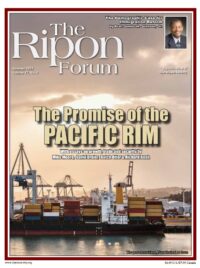
Neither economic nor social or humanitarian arguments have garnered sufficient political support in Washington to enact comprehensive immigration reform legislation. There is, however, a strong demographic case which may resolve the current political impasse and mobilize bipartisan Congressional support for an immigration reform policy that enhances the nation’s attractiveness as a place to live and do business.
At the most general demographic level, it is widely recognized on both sides of the political aisle of Congress that the U.S. population is aging. Ongoing debates regarding the future viability of Social Security, Medicare, and Medicaid programs are emblematic of the critical role population aging plays in Washington politics.
But policymakers seemingly are either unable to recognize or unwilling to acknowledge the critical link between population aging on the one hand and immigration reform on the other. Because our native born population is aging, we simply cannot thrive and prosper in the hyper-competitive global economy of the 21st century if we close our borders to new talent and fail to find a place for the 11.5 million unauthorized immigrants who are already living on our shores. And if we are not globally competitive, we will not be able to build the economy that will help to sustain the social safety net programs that serve seniors and other vulnerable populations.
…policymakers seemingly are either unable to recognize or unwilling to acknowledge the critical link between population aging on the one hand and immigration reform on the other.
At a more granular level, several forces are driving the aging process — the so-called greying of America — which further amplify the need for immigration reform. Three are highlighted here.
First, U.S. fertility rates have declined sharply, especially among native born non-Hispanic white women, over the past quarter century. The decline is related at least in part to the growing role of women in the paid workforce. Some women have responded to increased opportunities to work by delaying marriage and/or childbearing until they are well established in their careers. For others, career goals and aspirations have overshadowed marriage and/or childbearing altogether. Whatever the reason, the fact remains that the percentage of U.S. women between the ages of 40 and 44 who have chosen not to have children doubled between 1976 and 2006, rising from 10% to 20%.
As a consequence of this demographic dynamic, the non-Hispanic white total fertility rate — a statistical measure of the number of children a couple needs to have to replace them — has been below the replacement level (1.9 vs. 2.1) for almost two decades. In part for this reason, and despite the fact that aging Boomers and Pre-boomers are living longer, “[d]eaths exceeded births among non-Hispanic white Americans for the first time in at least a century…” during the year ending July 1, 2012.
Second, and further fueling the necessity for immigration reform, these two demographic forces — declining fertility and population aging — are threatening the future fiscal and economic viability of some U.S. communities. Between 2010 and 2012, 17% of the nation’s 366 metropolitan areas (61) and 30% of the nation’s 527 micropolitan areas (160) lost population. In nearly all of these communities, deaths exceeded births and internal migration was not sufficient enough to offset natural population loss. Bereft of mainstream economic and employment opportunities, these communities are literally dying.
But ample evidence exists regarding the critical role that immigration can and will have to play in their revival. We know, for example, that an even larger number of U.S. metropolitan and micropolitan areas would have lost population were it not specifically for the influx of movers from abroad between 2010 and 2012. Immigrants are breathing new life into these communities, fostering both population growth and economic and employment growth through their entrepreneurial acumen. Across the nation, immigrant newcomers were critical drivers of growth in almost all of the metropolitan areas and micropolitan areas that gained population between 2010 and 2012.
Across the nation, immigrant newcomers were critical drivers of growth in almost all of the metropolitan areas and micropolitan areas that gained population between 2010 and 2012.
Finally and perhaps most importantly, especially given the aging of our native born population, our elected officials must recognize that immigration is highly selective of young people. There is, for example, a 15 year differential between the median age of native born non-Hispanic whites (42) and Hispanic immigrants (27) in the U.S. Taking this age differential into account, it is a strategic imperative for our nation to move beyond our pre-occupation with fiscal impacts and focus instead on the broader and longer term economic impacts of immigration.
Even if the short-term fiscal impacts are negative, research suggests that these costs are often offset or overshadowed by the direct and indirect economic impacts of immigrant consumer spending in local communities. Our studies of the economic impact of immigrants in North Carolina and Arkansas before and during the recent recession revealed, for example, that these two states received in return for every dollar invested in K-12 education, health care, and corrections between $6 (AR during the recession) and $10 or $11 (NC and AR, respectively, prior to the recession) in business revenue and taxes from their immigrant populations. It should be noted here that these cost-benefit ratios emerged after subtracting roughly 20% of the immigrant purchasing power that was sent home in the form of remittances.
Demographically, we will need young immigrants to fuel future population growth and to sustain Social Security and other government benefit programs, as well as support the tax base of local communities, especially those that are currently losing population. But more than anything, we need their talent – in our universities, in our workforce, in our neighborhoods. For this reason, it is essential that the U.S. Congress move beyond political rhetoric and enact comprehensive immigration reform.
James H. Johnson, Jr., Ph.D. is the William R. Kenan Jr. Distinguished Professor of strategy and entrepreneurship and director of the Urban Investment Strategies Center at the Kenan-Flagler Business School at the University of North Carolina at Chapel Hill.




